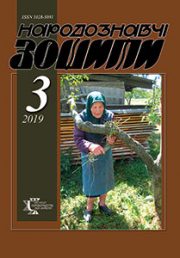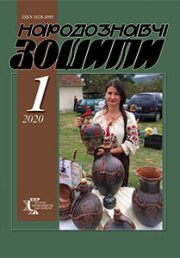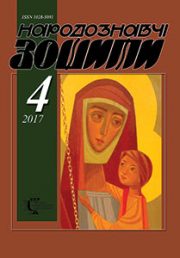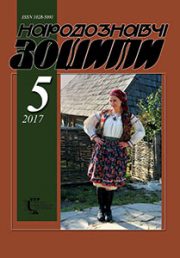The Ethnology Notebooks. 2020. № 2 (152), 330—349
UDK [398.341:398.4](477.86/.87+83)
DOI https://doi.org/10.15407/nz2020.02.330
RADOVYCH Roman
ORCID ID: http://orcid.org/0000-0002-1900-8948
Doctor of Sciences in History, Senior Researcher
of the Institute of Ethnology
of the National Academy of Sciences of Ukraine,
in the Department of Historical Ethnology,
Svobody Avenue 15, 79000,Lviv, Ukraine
Contacts: e-mail: radovychroman@gmail.com
Abstract. In the system of traditional rituals of Ukrainians, a prominent place is occupied by the complex of customs, beliefs and symbolic actions, associated with the construction of new housing, that actually includes the concept of «building ritual». In the proposed article the author aims to characterize the building rites in the territory of the eastern and central (middle) parts of Boikivschyna. Although some information on this field of knowledge is present in some publications, the building rites of this part of Boikivschyna have never been the subject of special studies, which determines the relevance of the proposed investigation. The area of research includes Dolinа, Rozhniativ, Bohorodchany districts of Ivano-Frankivsk region, Skole district of Lviv region and Mizhhiria, Volovets districts of Transcarpathian region. The chronological framework covers the end of the nineteenth and first half of the twentieth century. The object is — traditional Boiko`s building, and the subject — customs, beliefs and symbolic actions associated with its construction and commissioning. The methodological basis of the study is the principle of historicism in combination with the elements of structural and functional analysis and the use of basic methods of ethnological science: typological, complex and retrospective analysis, historical reconstruction, etc.
In the territory of the eastern and middle parts of Boikivschyna, as well as everywhere in the Boikivschyna, the whole process of housing construction — from the choice of place, the procurement of building material, up to the settlement of the family — was accompanied by complex of magical rituals and actions that combined as rational and illusory elements. The complex of rituals related to the construction of a new dwelling and its commissioning includes several cycles: 1) the choice of location; 2) housing construction; 3) ceremonial entrance to the new building, — each of them in turn, is divided into several stages. In the proposed work particular attention is also given to the timing of the beginning of housing construction and the role of the master in the customs and beliefs of Ukrainians.
The above material makes it possible to state, that the complex of rituals, customs and beliefs associated with construction that have resided in the study area, have a number of features common to the appropriate set of general Ukrainian construction or rituals around the Carpathian region. At the same time, some aspects of this complex in the specified areas have a distinct local (characteristic only for the eastern and middle parts of Boikivschyna) or local (characteristic of a group of villages or only one or two settlements) peculiarities.
Again, the material presented and analyzed from the territory of the eastern and central parts of Boikivschyna indicates that the entire complex of building rites in the respondents’ memory is sufficiently stable, and a number of different customs, beliefs, divisions, prohibitions, ceremonies, etc. (albeit somewhat reduced) are used in the construction of housing by construction workers of different age groups even nowadays.
Keywords: Boikivschyna, building rite, choice of place, building tree, divination, housewarming.
Received 20.01.2020
REFERENCES
Budzan, A. (1982). Field ethnographic materials. In Archive of the Institute of Ethnology of the National Academy of Sciences of Ukraine. F. 1. Ds. 2. Un. save 279 [in Ukrainian].
Hoshko, Y., & Fedaka, P. (1987). Customs and beliefs related to the construction of residential and commercial buildings. Folk architecture of the Ukrainian Carpathians of the ХV—ХХ centuries (Pp. 237—243). Kyiv: Naukova dumka [in Ukrainian].
Schnaider, J. (1912). From the life of the gorals by Lomnica river. LUD: Quarterly ethnographic (Vol. 18, pp. 141—214). Lviv [in Polish].
Nahorniuk, O. (2009). Folk topography. Ethnoculture of Rivne Polissia (Pp. 239—264). Rivne [in Ukrainian].
Radovych, R. (2015). National architecture Staryi Sambir district in the nineteenth — first half of the twentienth century (housing and economic complex). Kyiv [in Ukrainian].
Andriievska, T. (1998). Traditional folk housing in the village Kosmach. Proceedings. Museum of Folk Architecture and Life in Lviv, I, 37—42 [in Ukrainian].
Potushniak, F. (1940, 6 August). Construction of houses in the folk beliefs. Russkaia Pravda [In Russian].
Myloradovych, V. (1991). The life-being of a Luben peasant. Ukrainians: popular beliefs, belief, demonology (Pp. 170—341). Kyiv: Lybid [in Russian].







